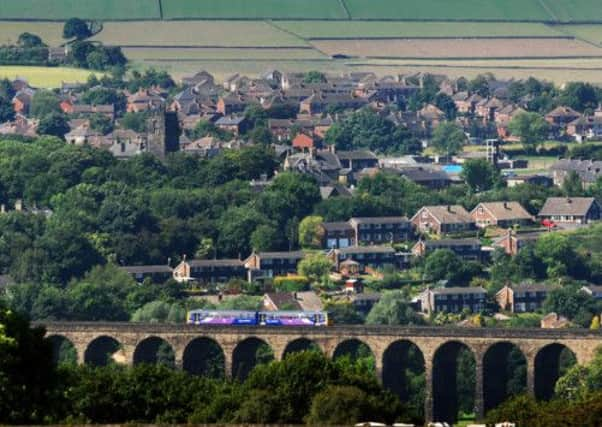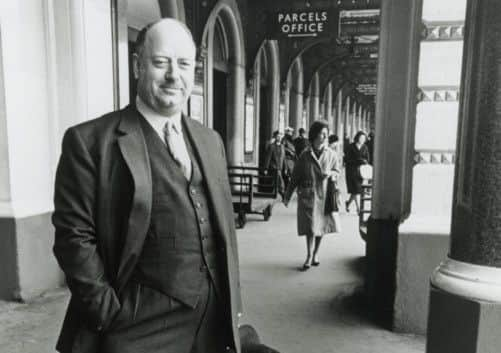The ones that got away


York’s National Railway Museum is very even-handed about Dr Richard Beeching. Its exhibition marking the 50th anniversary of his controversial report describes him as “the man who reshaped Britain’s railways”. True enough, but most people are a bit more emotive about it than that.
For every person who supports Beeching’s cost-efficient cuts – more than 2,000 stations and 5,000 miles of track – there are dozens who revile them and see him as a reckless axe-man, hacking apart Britain’s social fabric. They don’t take Beeching, whose centenary falls on April 21, at his own word: that his cuts were “surgery, not mad chopping”.
Advertisement
Hide AdAdvertisement
Hide AdAs chairman of the British Railways Board, he was paid £24,000 a year, more than the Prime Minister, at a time when an engine driver with 40 years of service earned £676. As a result of his report, 70,000 jobs were lost. “Skilled railwaymen, who for generations had loyally given their all to the ‘company’, were tossed aside for the sake of a politically motivated love affair with road transport,” laments railway author Julian Holland in his newly published Dr Beeching’s Axe 50 Years On.


This impressively researched and exhaustively thorough book sets out to include every line that was closed – well over 200 of them – but it’s partly thanks to its intriguing list of “lines that got away” that I’m at the museum at the end of a day-long Grand Yorkshire Rail Tour. It started in Sheffield and has taken in Huddersfield, Leeds, Harrogate and York, before a train back to Sheffield. A whistle-stop tour, mostly on Northern Rail trains, including a couple of lines Beeching’s whistle didn’t stop.
I’ve had plenty of time on the rails to appreciate the book. It’s packed with photographs – the last day of services on the Scarborough to Whitby line, “Happy days at Hornsea station in the early 1960s with a DMU recently arrived from Hull,” and – perhaps aimed at men with a certain number-ticking fondness for trains - “Class ‘J39/2’ 0-6-0 No 64821 and a ‘B16’ 4-6-0 pound up the gradient through Thorner station with a southbound freight on the heavily-graded Wetherby to Leeds line on a rainy day, circa 1959.” Heavy trains, Holland points out, needed “rear end assistance” on parts of the line.
You can see the results of the closures just down the corridor from the museum’s surprisingly low-key exhibition. A tiled wall map from around 1900 shows lines spidering across Yorkshire and the North East. The map – there’s another one on York station concourse – shows the railways at their zenith. Every cow shed had its own station, even if the passengers might amount only to three men, two dogs and a milk churn.
Advertisement
Hide AdAdvertisement
Hide AdIt’s the station names that get you. Trains from York to Beverley stopped at High Fangfoss and Kiplingcotes. Selby to Doncaster took in Heck, Balne and Moss. Hull to Hornsea went through Swine, Skirlaugh and Sigglesthorne. Malton to Driffield called at Wharram, Wetwang and Fimber. Wormald Green and Melmerby lurked between Harrogate and Northallerton; Bubwith and Foggathorpe between Selby and Market Weighton.
There are some equally unlikely station names on my round-trip, inspired, as I say, by some of the lines that were earmarked for closure but, thanks to protests or political expediency, were subsequently reprieved. Some are worth travelling on for their own sake, glimpses of more measured times, when “stopping trains” meandered through the countryside picking up travellers as they went.
Three reprieved Yorkshire lines are among Britain’s most scenic – the celebrated Settle-Carlisle, the Esk Valley Line from Middlesbrough to Whitby, which deserves to be just as celebrated, and the line on which I start from Sheffield: the Penistone Line to Huddersfield, via Denby Dale, Brockholes and Berry Brow.
Beeching planned to close its most scenic section between Penistone and Huddersfield, but thankfully it was saved (and, like the Esk Valley Line, it now has its own campaigning group, the admirable Penistone Line Partnership). It’s a lovely journey. Many years ago, after having to cancel a long-planned trip on the Trans-Siberian Railway, I turned to the Penistone line for a bit of consolation. For Vladivostok, read Wombwell.
Advertisement
Hide AdAdvertisement
Hide AdI’m travelling on one of the snowiest days of our winterous spring and the train is packed with commuters warming their hands on cardboard cups of coffee they’ve bought on Sheffield station. As we pull out, the sun sparkles on the snow, turning even wasteland into wonderland.
The big surprise for newcomers will be the fine countryside round Barnsley. It glows green in summer, but today it’s monochrome, an almost abstract landscape of stone walls and trees etched in black on a snowy white canvas. There’s a great feeling of height and openness, particularly as we cross the 29-arched viaduct at Penistone, the first of several on my trip. We edge through canyons of snow drifts. Snow flurries patter on the window as Huddersfield suddenly comes into view, as big and hilly as a rugged Pennine city should be.
Its station is famous, a stately station to match many a stately home. And it has a treasure in its buffet on platform four. I scan the menu. Only fried eggs are listed. “Do you do poached eggs?” I ask, and feel instantly effete. They don’t, so I have fried (delicious) and then step outside the station to pay my respects to the bustling statue of Harold Wilson, whose 1964 Labour government eventually brought swingeing railway cuts to an end.
To get to Leeds for my second reprieved line, I take the train through Dewsbury. It’s a good vantage point for the town’s impressive Victorian buildings and the proud sign on a former mill: “Machell Bros: Shoddy and Mungo Manufacturers”.
Advertisement
Hide AdAdvertisement
Hide AdAs we pull into Leeds, the sky is an alarming dirty yellow. Armageddon over Armley? Beeching planned to close the line between Harrogate and York, which starts in Leeds. But it’s a bit of a secret line. The station’s departure boards suggest it finishes at Poppleton, the last stop before York: presumably so unsuspecting passengers don’t get on expecting to reach York in the 25 minutes mainline trains take. The slow stopping-train, looping round through Harrogate, takes 70.
Practically everyone on board – well, everyone under 30 – is preoccupied not with Yorkshire but with Elsewhere, the land of phoning, emailing, texting, tweeting, Facebooking: modern life’s weapons of mass distraction.
Why not just sit and watch the world go by? Why not experience the Bramhope Tunnel, which is like a theatre curtain coming down between scenes in a play? Before it comes down, the backdrop is the urban fringes of Leeds. As the train emerges at the other end, the backdrop is countryside.
A highlight is the first glimpse of the viaduct before Harrogate. The train slows carefully round the curve and as we cross the viaduct it feels like low-flying. And then across the gorge at Knaresborough, the town clustered picturesquely up its slopes like many a railway modeller’s dream.
Advertisement
Hide AdAdvertisement
Hide AdThat’s pretty much it for drama as flat farmland stretches out to York and we stop at the fabled Poppleton. The Minster looms in the distance and we ease into York’s great curving second cathedral: its station.
I toy with getting the stopping train back to Sheffield, via Pontefract – two trains a day in each direction. But no, late in the afternoon, even the charms of Ulleskelf, Church Fenton and Sherburn-in-Elmet can’t lure me from the main line.
This time, the train is full of business people bawling into their mobile phones. All I’d say to the woman who was in the seat behind me is that her all-too-audible conversation has told me more about the two men in her life than I suspect either of them would want me to know.
Beeching: 50 Years On exhibition runs at the National Railway Museum until June 16. (0844 815 3139, www.nrm.org.uk.
Advertisement
Hide AdAdvertisement
Hide AdDr Beeching’s Axe 50 Years On by Julian Holland, published by David and Charles is priced at £18.99.
Northern Rail (www.northernrail.org) has a range of Rail Rover tickets covering the North of England. Lamb and spinach curry